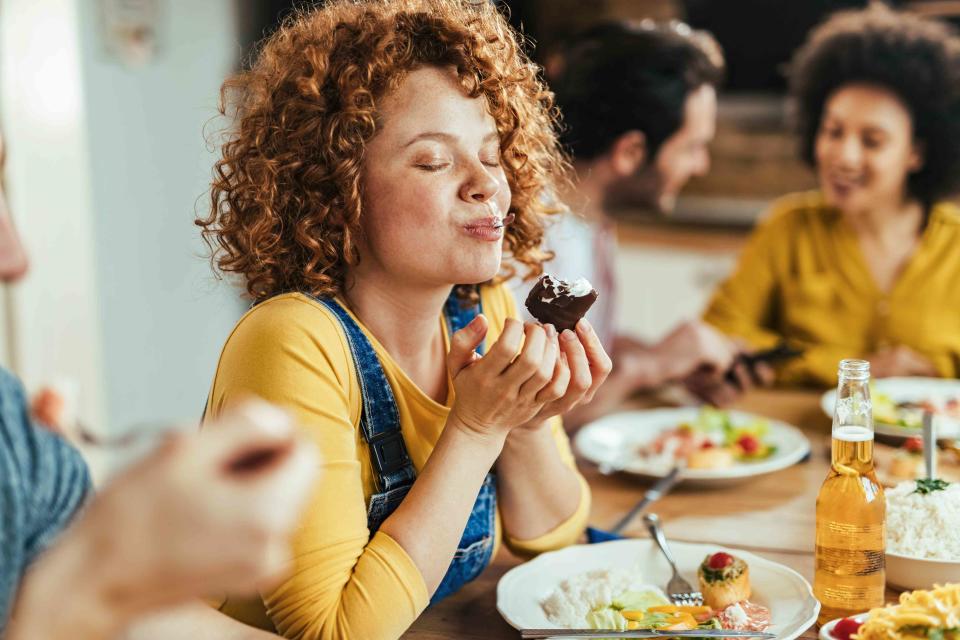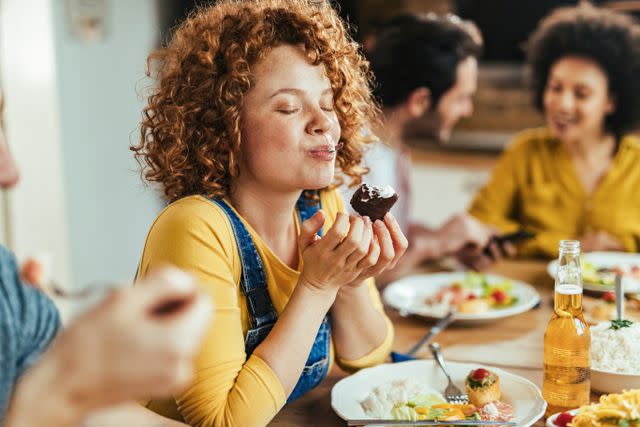How to Taste Your Favorite Foods and Drinks More Fully
Want to hone your sensory abilities and improve your palate? Follow this advice from a tasting expert and start savoring every meal.

Drazen Zigic / GETTY IMAGES
Have you ever had that "aha!" moment when you take a bite of, say, pesto pasta, fragrant with basil, or a sip of flinty sauvignon blanc, and all of the flavors not only sing in your mouth but envelop your senses? That heightened awareness doesn't have to be an isolated incident.
According to certified taster Mandy Naglich, who is also a drinks educator, advanced cicerone (the highest level of certification for beer), and author of How to Taste: A Guide to Discovering Flavor and Savoring Life, you can taste food to its fullest extent, gaining more of an appreciation for what you eat with just a few simple steps. "Your tasting abilities are like strengthening a muscle," Naglich says. "Practice and repetition will improve them (rapidly) and ignoring them will cause them to slip."
Meet Our Expert
Mandy Naglich is a certified food and drink taster, drinks educator, advanced cicerone, and the author of How to Taste: A Guide to Discovering Flavor and Savoring Life.
Related: What Is Umami? Plus, How to Use This Savory Flavor in Your Cooking

Drazen Zigic / GETTY IMAGES
Name What You Taste When Eating or Drinking
To start cultivating your tasting acumen, you need one key thing: focus. "Simply paying attention to what you taste when you eat and drink every day will be an immense help when you're looking to appreciate flavors [in chocolate or wine]," says Naglich. For example, if you take a sip of your morning java and mentally say "coffee" then add milk and note "coffee with milk," those flavors will register the next time you nibble chocolate with a hint of coffee.
Develop Your Taste Memory
Creating a visual memory of a flavor helps you to hold onto it, and you'll be well on your way to accruing a mental library of flavors. If you're eating a sharp cheddar with notes of hazelnut and saltiness, imagine yourself picking hazelnuts in a seaside orchard. When you sample a similar cheddar down the line, you might conjure up that image.
Real-life experiences also figure into flavor memories. For instance, if you're in Provence enjoying a glass of rosé, take notice of where you are, who you're with, how the wine tastes, and how you feel.
"The next time you taste a French rosé from Provence, you can use this sensory memory to time travel back to your vacation. A well-formed sensory memory will give you the feeling of being back in the exact same chair, experiencing the same emotions as you were when you created the memory," says Naglich.
Related: What Is Furikake? Learn More About This Savory, Salty Seasoning Blend That Can Elevate Any Dish
Try This Tasting Method
To deepen your tasting skills, expand your appreciation for what you eat, and collect valuable insights about foods and flavors, go the extra mile and follow this seven-step practice that Naglich developed (and covers extensively in her book). There's nothing arbitrary about the approach—Naglich interviewed over 100 professional tasters and scientists to land on and confirm the following steps:
Set(ting): Observe your surroundings, factoring in details like plates and glasses. Your senses (sight, touch, sound, and smell) play a large role in assessing your setting. Red walls might make food taste sweet, and chilly environs make whiskey taste better, while smell impacts taste memories the most.
See: Seeing allows you to appreciate that perfect slice of cake before you dive in, and decipher any flaws in the food, like waxy-looking chocolate that's "bloomed." That said, appearance alone can't tell how flavorful foods will be.
Sniff: This step entails a series of five sniffs, with every sniff increasing the concentration of each fragrance.
Swirl/snap: Swirling spirits, snapping (say, cutting into an apple), or smearing cheese is another opportunity to work the olfactory receptors, prompting a release of volatile aromas.
Sip/sample: Take a sip or bite of whatever you're tasting to see if it matches the aromas you've been sniffing, then another, to weigh its mouthfeel and the pleasantness of its aftertaste.
Swallow/spit: Eating means swallowing but that's not always true with tasting, especially if you're trying several wine, spirit, or coffee samples at a clip. (Before spitting in front of others, practice on your own!)
Sit and synthesize: After collecting data over these six steps, reflect on, and enjoy, what you've tasted, choose how you want to remember it, and store it in your flavor memory.
Other Things That Impact What We Taste or Crave
As you become more attuned, you'll start to pick up on sensory inputs, and how they impact taste, says Naglich.
Starting your day with something a bit bitter, like coffee, or grapefruit juice, for example, will set you up to enjoy more bitter things throughout the day, like a kale Caesar at lunch.
If the thermostat is low, you might crave something warming or comforting, like ramen, and if you're feeling warm, a crisp salad or sushi. Warm yellow light makes a snack more satisfying, while blue lighting (no surprise) interferes with taste.
Glassware and cutlery also figure into the equation. "If you splurged on a bottle of expensive wine for dinner, there is a way to make it taste just a little bit better: serve it in your heaviest glassware," says Naglich. Paper-thin wine glasses, on the other hand, detract from the experience.
The same goes for loud music, which can make it difficult to focus on taste. "The thump of a bass or echo of loud music literally jostles the taste messages as they travel through our inner ear, changing the way we perceive the meal!" she says.
With time, and a little effort, you'll start to sharpen your senses. "As you move throughout the day, at every meal, take a second to take in the aroma of what you eat and drink and try to connect it to a past memory or another food experience," says Naglich. "Soon, tasting notes will be jumping out of a bowl of risotto or a glass of wine!"

